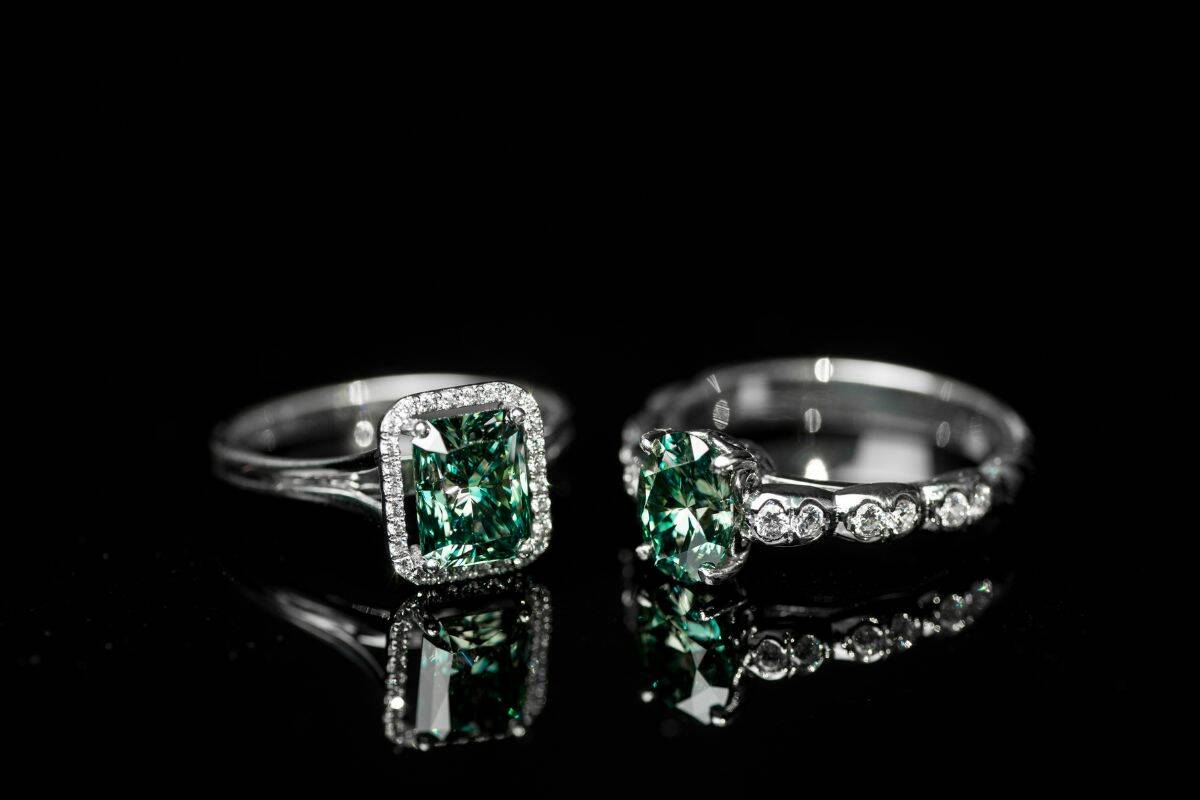Thanks to an extremely successful marketing campaign by DeBeers called ‘Diamonds are Forever’ which was launched in 1947 people have associated these gemstones with longevity and permanence.
So it is not surprising that diamonds became the most popular choice for engagement rings.
But do engagement rings have to be diamond? We have found 12 alternatives for diamond engagement rings, and they are all absolutely stunning in their own right.
Engagement rings do not have to be diamond and there are many different types of gemstones that can be used for an engagement ring.
Lab Grown Diamonds
If you are not going to choose a natural diamond as an engagement ring then what about a synthetic diamond?
The world’s leading diamond company, DeBeers is at the forefront of developing synthetic diamonds which are aimed at businesses as well as consumers.
Their Lightbox Jewelry uses laboratory grown diamonds as a more affordable alternative to mined diamonds.
When you buy a natural diamond the price is calculated based on the weight of the stone combined with the cut, clarity and color. This increases the uniqueness and rarity of the diamond.
With a lab grown diamond this doesn’t apply as there is the ability to apply consistency to the cut, clarity and color which is not possible with mined diamonds.
Other companies produce synthetic diamonds but DeBeers have the most patents of any diamond company and are able to maintain a stable price for their products where others tend to follow the natural diamond market.
A one-carat natural diamond will cost approximately $3,000 whereas a synthetic diamond can cost anywhere between $800 – $1500.
For an engagement ring however, it will be very hard to tell the difference for the untrained eye.
Sapphire
If you are really not interested in having a diamond engagement ring, natural or synthetic then you may want to choose a different kind of gemstone such as a sapphire.
Sapphires symbolize faithfulness and sincerity so make a beautiful choice for an engagement ring.
When people imagine a sapphire they will typically visualize a dark blue gemstone but sapphires come in a range of colors.
Although blue sapphires are the most common and make a stunning engagement ring.
One of the most expensive colors of sapphire is the Kashmir sapphire.
This is a cornflower blue and very rare, hence its price tag of around $200k per carat for gem quality stones with lower quality fetching $5,000 per carat.
Sapphires tend to weigh more than diamonds, so a one-carat sapphire will be smaller than a one-carat diamond in your engagement ring.
It is also possible to have a pink sapphire or even a yellow sapphire, so you are not limited to just blue.
Aquamarine
Aquamarine belongs to the same family of minerals as emeralds.
However, these semi precious gemstones are a much paler color. Its name originates from the 1700s and means water of the sea because of its hue.
It looks very similar to blue topaz, but aquamarine is rarer and therefore more valuable.
Aquamarine is also naturally colored whereas blue topaz is created when colorless topaz is treated with radiation.
As an engagement ring, aquamarine makes a beautiful alternative to diamond.
With its pale tones it goes with most coloring and has a delicate appearance. However, as a gemstone it is not as hard as diamond and can be scratched if exposed to rough wear.
They also don’t have the same brilliance of diamonds but have exceptional clarity.
An aquamarine gemstone looks stunning in a ring setting with its pale blue coloring. Per carat, you may pay between $675 and $1,000 for an aquamarine engagement ring.
Emerald
The Ancient Greek goddess Aphrodite was the first to attribute to emerald the symbolism of eternal love.
As an engagement ring we can’t think of a more fitting alternative to a diamond.
Emeralds are among the rarest gemstones and this is why they are considered so desirable and valuable.
This makes it a wonderful alternative to a diamond engagement ring and one that has been embraced by royalty throughout history.
The clarity of these stones is graded by the naked eye rather than through magnification as is the case with diamonds.
This is because the inclusions in emeralds are highly visible; inclusions are any materials trapped inside the gemstone such as gas or air bubbles.
Like diamonds, emeralds too can be created in a laboratory, giving you the option to have a beautiful engagement ring at a more reasonable price.
Mined emeralds are priced according to their color and placement of inclusions.
Expect to pay around $1,000 per carat for a good quality emerald, although the highest quality can sell for as much as $100k per carat.
Ruby
Considered one of the four original gemstones along with sapphires, emeralds and diamonds, rubies have been prized for their rarity and beauty for thousands of years.
A ruby is a fitting choice as an engagement ring as red has long been the color of passion and love.
The look of a ruby stone makes it seem as if it is glowing from within, as if there is a fire smoldering inside.
Perfect for a declaration of love to your intended.
They are also a very hard gemstone, so this makes a ruby ideal as a ring that you will wear every day.
As with all gemstones the 4 Cs are applied to the quality of a ruby. These are color, clarity, cut quality and carat weight.
Color and clarity are the most important factors which will determine the price that you pay.
Typically you will pay around $1,200 to $1,500 for a one-carat ruby. While they don’t sparkle like diamonds, rubies do shimmer under light.
Morganite
Morganite is a type of pink beryl and was originally called rose beryl.
However, a gemologist renamed it to honor his patron, the philanthropist J.P. Morgan who was a prolific gem collector.
This gemstone looks gorgeous in the center of an engagement ring setting with its peach to pink blush tones and sparkles beautifully under the light.
They are sought after for their high degree of brilliance and clarity.
As with other beryls such as emeralds and aquamarine, morganite is a softer stone. So although it can be worn as everyday jewelry it should be protected against rough treatment.
Morganite is an affordable gemstone and so would make an excellent alternative to a diamond engagement ring if you are on a budget.
A one-carat morganite will cost in the region of $400-$500, and it looks particularly good on a rose gold setting.
Topaz
With all the sparkle of diamond but without the hefty price tag, topaz is an excellent choice as an engagement ring.
It has a large color range, so you will be able to find exactly the right hue for your intended.
Topaz can also be cut into lots of different shapes and sizes, so there are many choices when it comes to the design and style of your engagement ring.
This is a durable gemstone and has a good resistance to scratching. However, direct impact may split it, so it is advisable to have it in a bezel setting to keep it protected.
A bezel setting is when the gemstone is either partially or fully encircled by the ring material.
It’s much more affordable than some other gemstones, although Imperial Topaz does sell for around $1,000 per carat.
Other varieties of topaz are much less expensive.
Amethyst
Throughout history amethyst was considered a protective stone and the color purple has always been associated with royalty.
Jewelry containing amethyst has been found by archaeologists from as early as 2000 BC and the stones were even mentioned in the bible.
There is a range of color available in amethyst gemstones from deep purple to pastel lavender or even pink. However, the most valuable is a reddish purple.
This stone would make a great alternative to a diamond engagement ring in terms of color, style and affordability.
A deep amethyst center stone surrounded by accent diamonds would make a stunning alternative to a diamond only engagement ring.
Amethyst is not the hardest of gemstones so although it works as everyday jewelry the ring should be treated with care.
A partial or full bezel setting would work well to protect it.
An amethyst will cost between $20-$50 per carat making it a very affordable option as an engagement ring.
Garnet
Garnet is a deep red gemstone with a resemblance to ruby but with a more brown undertone. It was a very popular choice for jewelry in the 18th and 19th centuries.
Today garnet is an affordable option for an engagement ring.
However, there are some more valuable types of garnet such as the orange spessartite garnet and the purplish red rhodolite garnet.
There is also a very valuable green colored garnet called tsavorite.
Garnet is a strong and durable stone and therefore is a good option for a ring that will be worn every day.
Depending on the quality and inclusions in the gemstone an affordable price for garnet is between $300-$500 per carat.
Tanzanite
The origin and only source of this gemstone is Tanzania, hence the name of this beautiful mineral.
It is found in a small mining area of the country in the hills at the foot of Mount Kilimanjaro.
The conditions for making tanzanite are so rare that the chances of finding it anywhere else on earth are a million to one.
This makes it a thousand times rarer than diamonds.
However, despite its rarity it is still reasonably priced and therefore quite affordable as an alternative to a diamond engagement ring.
Its beauty comes from the fact that it displays different colors depending on the direction that light comes through the gemstone.
The amount that you pay for tanzanite will vary according to the quality of the stone. Currently these prices are anywhere from $100 to $800 per carat.
Tourmaline
With a wide range of colors available, tourmalines are a wonderful choice as an alternative to a diamond engagement ring.
You can choose between blue, red, pink or clear, although blue tourmaline is much rarer than the red or pink varieties.
It is not as hard as some other gemstones but is still more than capable of holding up to everyday wear as an engagement ring.
Putting the stone into a bezel setting should keep it safe and protected.
One of the most beautiful things about tourmaline is that it shows different colors under different light sources.
Used as a central stone with accent diamonds a tourmaline gemstone will be a unique and stunning engagement ring.
Prices for tourmaline vary according to the color but range from $300 to $100 per carat.
Citrine
This gemstone is also known as the merchant’s stone, being associated with good fortune and success with money.
It is a type of quartz and the color varies from a transparent yellow to a brownish orange hue which comes from the iron in its structure.
It is often confused with topaz but is more affordable. Citrine is a relatively tough gemstone and will cope well with being a piece of everyday jewelry.
However, it can be brittle, so care should be taken not to subject it to any kind of impact.
The price of citrine will vary depending on the quality of the stone but is between $5 to $30 per carat. This makes it a very affordable option as an engagement ring.
Final Thoughts
The gemstone that you choose for your engagement ring should reflect the relationship that you want to commit to and should not be based on the price tag.
Of course, you want the ring to last like your marriage, forever, but don’t get caught up in paying more than you can afford for an engagement ring, it is the sentiment that counts.
We hope you have enjoyed this guide to alternatives to diamond engagement rings.
We hope you have enjoyed this guide to alternatives to diamond engagement rings.
- Full Breakdown: How Much Does Your Dream Disney Wedding Really Cost? - April 13, 2023
- Magical Beginnings: 11 Steps for Planning Your Dream Disney Wedding - April 8, 2023
- 40 Unique Gifts For Daughter On Her Wedding Day - March 25, 2023




Leave a Comment